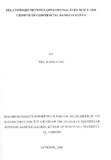| dc.description.abstract | The research aims to examine whether the efficiency structure hypothesis holds true for Kenyan commercial banks. The efficiency structure hypothesis, developed by Demesetz (1973),is the proposition that more efficient companies will better compete, develop and grow in scale, thus resulting in an increase in the degree of market concentration. Hence, under this hypothesis, it is expected that the greater the degree of market concentration, the more efficient the market. This research
design was descriptive research design with a quantitative approach in order to generate in‐depth information from secondary data as obtained from central bank of Kenya. The research was concentrated in the recent performance of commercial banks in Kenya between the periods of 1998 to 2007. The research consisted of 42 commercial
banks operating in Kenya under licence by the Central Bank of Kenya. This study used accounting data of individual banks drawn from the years 1998 – 2007. The time period was selected considering that it offers recent time series observations and it constitutes a period of major changes for the Kenyan banking system. This study aimed to investigate the relationship between growth and operational
efficiency as a performance measure of commercial banks in Kenya. Firstly, we derived the co‐efficient efficiency of for each bank. Secondly, we estimated the annual percentage growth rate of earning assets for each bank. We finally tested the
relationship between annual percentage growth rate and measure of operational efficiency as used in this study. Correlation coefficient r, was used to establish the association and strength of the relationship. Coefficient of determination R2, told us how much of the variance in annual percentage growth rate of earning assets of each the variance in bank growth as measured by annual percentage rate of growth of
earning assets. This implies that the more efficient commercial banks are, the more they grow in terms of their annual growth of earning assets. The results point to the fact that growth in commercial banks is significantly influenced by their efficiency in advances. The study recommends that banks in Kenya can be more effective in mobilising deposits when this is pursued with higher interest rates rather than depending on administrative devices alone, such as more branches and more personnel. The study also recommends that the strategies used by other efficient banks in deposit mobilisation are recommended to the other banks which wish to expand as rapidly as the more efficient ones. | en |

